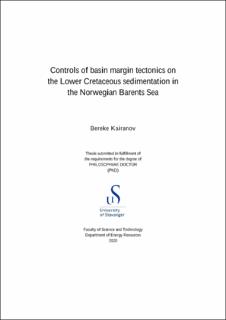Controls of basin margin tectonics on the Lower Cretaceous sedimentation in the Norwegian Barents Sea
Doctoral thesis
Permanent lenke
https://hdl.handle.net/11250/2658512Utgivelsesdato
2020-06Metadata
Vis full innførselSamlinger
- PhD theses (TN-IER) [18]
Originalversjon
Controls of basin margin tectonics on the Lower Cretaceous sedimentation in the Norwegian Barents Sea by Bereke Kairanov. Stavanger : University of Stavanger, 2020 (PhD thesis UiS, no. 530)Sammendrag
Structural styles and stratigraphic patterns along North Atlantic margins display a large spectrum of complexity and variability. An extensive amount of subsurface data from the north-central and south-western Barents Sea are used to: (1) at a larger scale understand how various plate tectonics regimes controlled structuring, faulting and sedimentation along the northern and southern margins of the Barents Sea; (2) at a smaller scale understand how the structural evolution of basin bounding faults impacted sedimentation in basins which were affected by one or more phases and multiple directions of extension; and (3) improve the knowledge about the paleogeography of the Barents Sea. In order to fulfil these objectives, this research consists of a systematic analysis which is summarized in five journal articles.
Paper 1 improves the existing knowledge of the Early Cretaceous tectonostratigraphic development of the north-central Barents Sea based on observations from subsurface data, structural and plate tectonic restorations in an area distal from the northern margin of the Barents Sea. As result of this work, compressional tectonics in the Early Cretaceous is suggested to be induced by the opening of the Canada Basin which triggered reactivation of Late Palaeozoic normal faults in reverse mode. Reverse movement along these faults caused the formation of NE oriented structural highs and anticlines, which controlled and routed the progradation of Lower Cretaceous clastic material from the northern to the southern margins of the Barents Sea.
The second paper focuses on understanding the Early Cretaceous structural evolution of the Tromsø Basin (proximal southern margin of the Barents Sea) in the context of the geodynamic processes acting in the southwestern Barents Sea. We propose an Early Cretaceous structural evolution of the Tromsø Basin which explains the formation of compressional features during rifting in the south-western Barents Sea.
2D gravity modelling and 2D structural restoration along a key regional composite seismic section, facilitated the interpretation and assessment of geodynamic constrains for the deeper structures below the Lower Cretaceous. These reveal thinner crust below the Tromsø Basin as compared to the Sørvestnaget and Hammerfest basins, which is suggested as the result of oblique extension in the southwestern margin of the Barents Sea.
In the third paper and at a smaller scale, we integrate stratigraphic and structural observations with throw backstripping and time thickness maps to define the growth processes of a basin-bounding normal fault in the northern Polhem subplatform. During the initial Early Cretaceous rifting, the fault system consisted of at least five en-echelon segments, which were ca. 5–10 km long. Throw backstripping indicates that fault segments were hard-linked after this initial stage to form a single 40 km long fault zone. Cross fault incised valleys provide additional information on the topographic response to fault growth. Major valley incisions at the fault linkage zones outline the extent of the individual fault segments and support early isolated fault growth.
The fourth paper focuses on a genetic correlation of the Lower Cretaceous succession between the north-central and south-western Barents Sea and Svalbard. The structural framework defined in paper 1 is used to locate the main sediment routes and progradation directions. The latest Valanginian to earliest middle Albian sequences in the offshore Barents Sea are correlated with the onshore Rurikfjellet, Helvetiafjellet and Carolinefjellet formations in Svalbard. This results in the reconstruction of four paleogeographic maps that show the progressive evolution and sediment distribution over the Norwegian Barents Sea for: (1) the earliest Valanginian, (2) the latest Hauterivian, (3) the middle to late Barremian and (4) the latest Aptian.
In the fifth paper, three tectonic events are suggested to control the deposition of the diachronous Lower Cretaceous clastic wedges around the Loppa High: 1) the latest Jurassic – earliest Cretaceous uplift of the Loppa High which triggered the deposition of the older wedges progressively eastwards in the northern Hammerfest Basin; 2) the late Barremian–Aptian faulting episode in the western flank of the Loppa High, which resulted in the deposition of shallow and probably deep marine wedges; and 3) the latest Aptian to earliest Albian tilting of the Hammerfest Basin and the Loppa High, which modified the sedimentation patterns in the region.
The results of this research can be applied beyond the Barents Sea, as they provide insights into margins and basins evolution, specifically on how: (1) oblique deformation along margins can control the inversion of pre-existing structures and routing of sediments, as well as modify paleogeography; (2) the growth of basin-bounding normal faults can affect sedimentation, with incised channels reflecting the early stage of fault growth; (3) paleogeographic reconstructions that reflect both the tectonic and stratigraphic setting can be used to understand sand distribution and sediment partitioning.
Består av
Paper 1: Kairanov, B., Escalona, A., Mordasova, A. et al. (2018) Early Cretaceous tectonostratigraphic evolution of the north central Barents Sea. Journal of Geodynamics, 119, pp. 183-198Paper 2: Kairanov, B., Escalona, A., Norton, I., Abrahamson, P. The Early Cretaceous evolution of the Tromsø Basin, SW Barents Sea, Norway. Submitted to Marine and Petroleum Geology.
Paper 3: Kairanov, B., Marin, D., Escalona, A., Cardozo, N. (2019) Growth and linkage of a basin-bounding fault system: Insights from the Early Cretaceous evolution of the northern Polhem Subplatform, SW Barents Sea. Journal of Structural Geology, 124, pp. 182-196
Paper 4: Grundvåg, S.-A., Marin, D., Kairanov, B. et al. (2017) The Lower Cretaceous succession of the western Barents Shelf: onshore and offshore correlations. Marine and Petroleum Geology, 86, pp. 834-857,
Paper 5: Marin, D., Escalona, A., Grundvåg, S-A. et al. (2019) Effects of adjacent fault systems on drainage patterns and evolution of uplifted rift shoulders: The Lower Cretaceous in the Loppa High, southwestern Barents Sea. Marine and Petroleum Geology, 94, pp. 212-229
